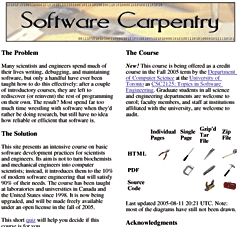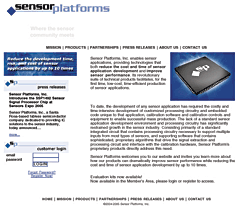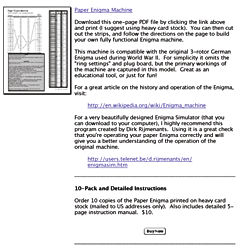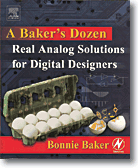 Several years ago I mentioned the Software Carpentry site, dedicated to teaching basic software engineering skills to engineers and scientists. Greg Wilson, who teaches at the University of Toronto, received a grant earlier this year from the Python Software Foundation to create an open-source version of his intensive course. An alpha version of his lecture notes is now available online. You can view the notes as individual Web pages or download them in a single PDF; there’s even a quiz to help you decide whether the course is right for you.
Several years ago I mentioned the Software Carpentry site, dedicated to teaching basic software engineering skills to engineers and scientists. Greg Wilson, who teaches at the University of Toronto, received a grant earlier this year from the Python Software Foundation to create an open-source version of his intensive course. An alpha version of his lecture notes is now available online. You can view the notes as individual Web pages or download them in a single PDF; there’s even a quiz to help you decide whether the course is right for you.
 With all the buzz about blogs (a sort of online diary) and the proliferation of blogs dedicated to every subject under the sun, it was only a matter of time before someone came up with a sensor-related one. Sensor Platforms has created the SensorTalk blog where George Hsu posts sensor-related mini-articles and waits for interested readers to comment. Do you like the idea of a sensor blog? Go check out this one and see what you think.
With all the buzz about blogs (a sort of online diary) and the proliferation of blogs dedicated to every subject under the sun, it was only a matter of time before someone came up with a sensor-related one. Sensor Platforms has created the SensorTalk blog where George Hsu posts sensor-related mini-articles and waits for interested readers to comment. Do you like the idea of a sensor blog? Go check out this one and see what you think.
 Finally, something fun! Here’s a simplified paper version of the Enigma code machine used by the Germans in World War II. Mike Koss has created a one-page PDF that you can print out and assemble; it captures the primary workings of the original 3-rotor German Enigma, minus ring settings and plug board. The site also includes links to the Wikipedia entry for the device (explaining its history and operating principle) as well as a link to an Enigma simulator.
Finally, something fun! Here’s a simplified paper version of the Enigma code machine used by the Germans in World War II. Mike Koss has created a one-page PDF that you can print out and assemble; it captures the primary workings of the original 3-rotor German Enigma, minus ring settings and plug board. The site also includes links to the Wikipedia entry for the device (explaining its history and operating principle) as well as a link to an Enigma simulator.
New to Bookshelves!
A Baker’s Dozen: Real Analog Solutions for Digital Designers
Author: Bonnie Baker
Published by Newnes, an imprint of Elsevier
ISBN: 0-7506-7819-4

This book gives digital engineers a solid arsenal of analog solutions to complement their digital circuit knowledge. Written by Bonnie Baker (who’s written for this magazine many times and was, at one time, on our Editorial Advisory Board), it is engaging, clear, and extremely accessible.
The thirteen chapters lead you through the basics of ADCs, including how to choose the right one for your particular application; filtering, op amps and their placement in linear systems; simulation; using PWMs, comparators, timers, and I/O gates; combining analog and digital in a system; noise; layout/grounding; and troubleshooting. In her final chapter, she discusses her approach to the book and its focus on helping you learn how to interface your circuits to the real world.
The final elements in this softcover book are the three appendices, which cover ADC specification definitions and formulas, how to read FFTs, and op amp specification definitions and formulas.
If you’re an engineer who wants to know more about good analog design, or if you’re a student looking to learn the same thing, check out this book.